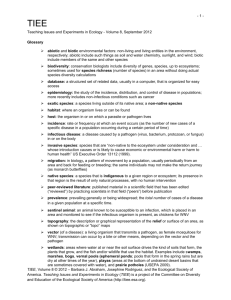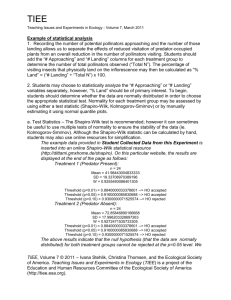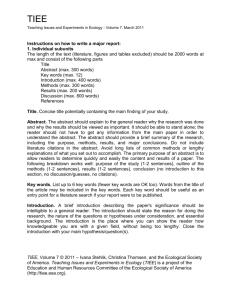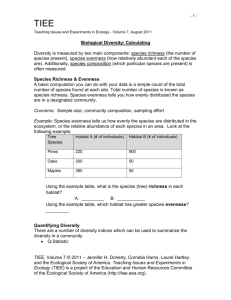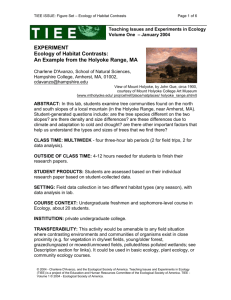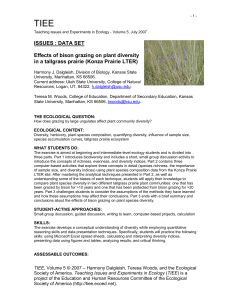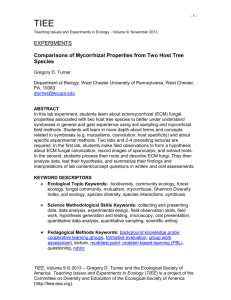Experiments Submission Form
advertisement
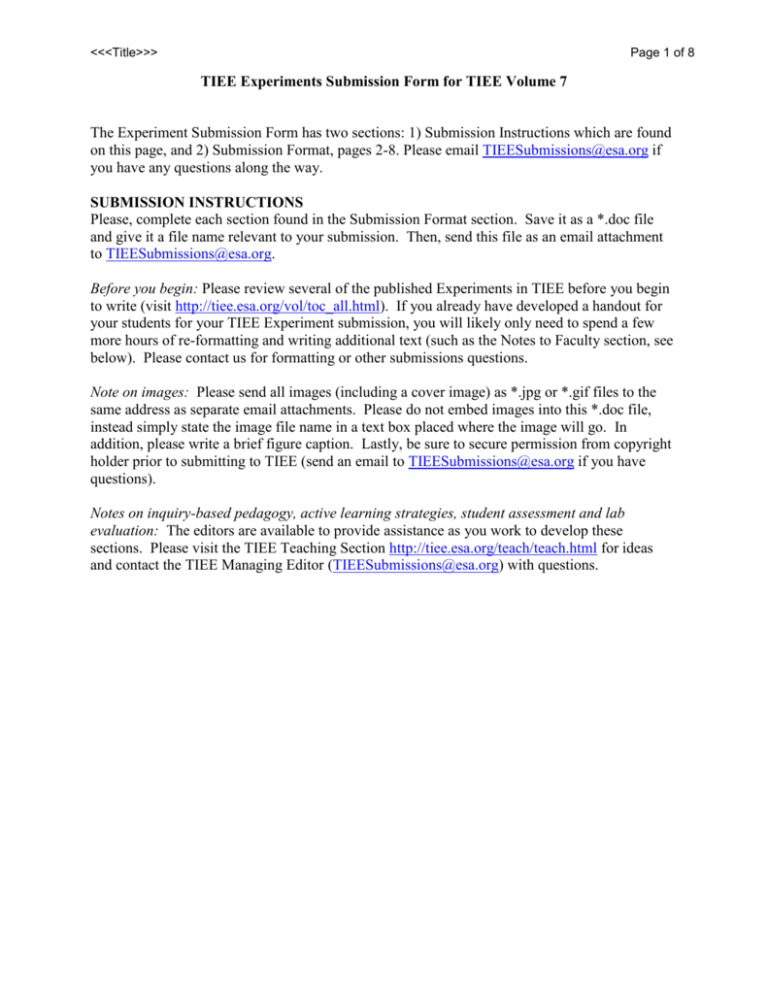
<<<Title>>> Page 1 of 8 TIEE Experiments Submission Form for TIEE Volume 7 The Experiment Submission Form has two sections: 1) Submission Instructions which are found on this page, and 2) Submission Format, pages 2-8. Please email TIEESubmissions@esa.org if you have any questions along the way. SUBMISSION INSTRUCTIONS Please, complete each section found in the Submission Format section. Save it as a *.doc file and give it a file name relevant to your submission. Then, send this file as an email attachment to TIEESubmissions@esa.org. Before you begin: Please review several of the published Experiments in TIEE before you begin to write (visit http://tiee.esa.org/vol/toc_all.html). If you already have developed a handout for your students for your TIEE Experiment submission, you will likely only need to spend a few more hours of re-formatting and writing additional text (such as the Notes to Faculty section, see below). Please contact us for formatting or other submissions questions. Note on images: Please send all images (including a cover image) as *.jpg or *.gif files to the same address as separate email attachments. Please do not embed images into this *.doc file, instead simply state the image file name in a text box placed where the image will go. In addition, please write a brief figure caption. Lastly, be sure to secure permission from copyright holder prior to submitting to TIEE (send an email to TIEESubmissions@esa.org if you have questions). Notes on inquiry-based pedagogy, active learning strategies, student assessment and lab evaluation: The editors are available to provide assistance as you work to develop these sections. Please visit the TIEE Teaching Section http://tiee.esa.org/teach/teach.html for ideas and contact the TIEE Managing Editor (TIEESubmissions@esa.org) with questions. <<<Title>>> Page 2 of 8 ***** SUBMISSION FORMAT 1. Your Experiment’s Home Page Experiment Title: < Please be clear and concise. > Abstract: < In a short paragraph of 50-100 words, offer a brief overview of the experiment, including the number of lab/class periods needed, and a listing of the activities students will do inside and outside of the classroom.> Author(s): <List the author(s) names, affiliations, work address, email address, and phone, also for summer submissions, please indicate summer contact info if different> Class Time: <Class time required for the experiment goes here> Outside of Class Time: <Time needed outside of class, for example for students to analyze their data, prepare talks, write up results, etc.> Student Products: <List and briefly explain as needed what are the major products upon which students will be assessed> Setting: <Explain in a sentence or two where the field work for the experiment needs to be conducted, if there are seasonal issues, and if there will be additional lab work> Course Context: <State a few details to indicate the type of course in which you use this experiment, and about how many students you teach per class or section at a time using this experiment> Institution: <State at what type of institution you teach (e.g., public, private, 2 year, 4 year, larger university, smaller undergraduate institution, etc.) > Transferability: <Explain in a sentence or two how transferable this experiment is to other institutional scales (majors vs. non-majors, intro or upper division courses), other geographies or study species, students with disabilities, and how well it would work in pre-college environments. Note: this is a shortened version of the text in the last subsection of Part 4, below> Acknowledgements: <Briefly explain the origin of the concept for this experiment: who was inspirational, whose creative activities led to your developing this experiment or unique version of a previously existing experiment "out there," who deserves mention in helping you to get this together and the role they played, and lastly what funding sources supported its development, if any. Please be as inclusive as possible.> Relevant Image: <Include an image as a separate attachment file that complements or in some way helps to illustrate the submission. In addition, please write a brief figure caption. Lastly, explain what you know about the image copyright? Who took it? Can we get permission to use it? > <<<Title>>> Page 3 of 8 2. Synopsis of the Experiment Principal Ecological Question Addressed: <State the major ecological research question posed and tested in the experiment> What Happens: <100-word summary of the major events that occur in the experiment> Experiment Objectives: <Numbered listing of the 3-4 major objectives of the experiment> Equipment/ Logistics Required: <List the major equipment/ logistics required for the experiment> Summary of What is Due: <Summarize the major student products for assessment, i.e., list the major things that students will do, produce, and present or submit for a grade for their performance in the experiment > Keyword Descriptors: <PLEASE carefully examine the keyword lists on the next page that are currently used in the SEARCH function on the TIEE site, and if at all possible choose relevant previously encoded words so that people will more easily find your experiment. If you need to use new keywords specific to your experiment, that’s perfectly fine, but please also use relevant previously recognized ones whenever possible. > Ecological Topic Keywords: <Ecological topic keywords in the experiment> Science Methodological Skills Keywords: <Science methods and skills keywords in the experiment> Pedagogical Methods Keywords: <Pedagogical methods used in the experiment> <<<Title>>> Currently recognized TIEE Ecological Content keywords: abiotic factors dispersal acidification disturbance adaptation duckweed agroforestry Eastern Hemlock alien species ecological economics allelopathy ecological services animal energetics ecosystems ammonification ecosystem function amphibian decline endangered species amphibian deformities energy flow aquatic ecology environmental adaptation autecology environmental education avail ecology environmental gradients bats environmental justice biocomplexity estuaries biodiversity eutrophication bioenergetics evolution bioengineered crops exotic species biogeography extinction biogeochemical cycles fast plants biophysical ecology feeding strategies bioremediation fisheries management biotechnology fir waves biotic factors fire ants bird community fire ecology structure food production Brassica rapa food web brood parasitism forest ecology brown tree snakes genetic engineering Bt corn gradient analysis carbon cycle grasslands carrying capacity green revolution cemetery greenhouse effect chemical ecology global nitrogen cycling climate change global warming coevolution GMO crops commensalism glyphosate tolerant crops community ecology gypsy moths competition heat flow conservation biology herbicide coral reef bleaching herbivores crosstown walk Holyoke Range deer impacts Hubbard Brook deer ticks human impacts decomposition hydrologic cycle deforestation indicator species demography individual ecology detritivores integrated pest management Page 4 of 8 intertidal ecology intermediate disturbance hypothesis invasive species keystone species landscape ecology life history Long Term Ecological Research LTER Lotka-Volterra model lyme disease marine ecology Melittobia metabolism microorganisms mimicry Monarch butterflies multispecies interactions mutualism Nasonia native species nitrification nitrogen cycle nitrogen fixation and saturation nutrient loading oceans overfishing overgrazing parasites parasitoids pesticides Pfiesteria phosphorus cycle photosynthesis plant ecology plant physiological ecology pollination population ecology prairie predation predator-prey relations productivity protists recycling regeneration sawfly galls <<<Title>>> scale seagrass decline seedling growth Shannon Diversity Index slope effects social ecology soil invertebrates species diversity species interactions stream ecology Page 5 of 8 stomata succession sustainability symbiosis temperature toxicology trophic dynamics urban ecology urban sprawl waste management watershed wetlands white-tailed deer wilderness wildfires wildlife management Yellowstone zebra mussels zero population growth Currently recognized TIEE Science Methodological Skills keywords: classification identify biotic - abiotic soil moisture analysis collecting and presenting data interactions soil texture analysis correlation versus causation library research statistics data analysis microscopy stochasticity evaluating alternative hypotheses model development and testing systematics experimental design natural history taxonomy factorial experiment oral presentation theoretical thinking field observation skills quantitative data analysis use of dichotomous keys field work quantitative sampling use of primary literature formulating hypotheses question generation use of spreadsheets graphing data random sampling use of graphing programs hypothesis generation and testing research proposal writing writing primary research paper scientific writing Currently recognized TIEE Pedagogical Methods keywords: alternative assessment guided inquiry assessment guided reciprocal peer authentic assessment questioning background knowledge informal groupwork probe inquiry Bloom's Taxonomy jigsaw Bloom’s Cognitive Skill metacognition Levels misconceptions bounded inquiry minute paper brainstorming muddiest point citizen's argument open-ended inquiry cognitive skill levels paired think aloud constructivism pairs check cooperative learning pairs share cooperative learning groups peer editing concept mapping peer evaluation evaluation portfolio assessment formal groupwork positive interdependence formative evaluation problem based learning gallery walk (pbl) games to teach ecology project-based teaching group work assessment pyramid exam scoring rubrics role playing roving reporter rsqc2 rubric rubric for student participation student active teaching think pair share think pair square turn to your neighbor two step exam write before discussion <<<Title>>> Page 6 of 8 3. Detailed Description of the Experiment (audience students) Introduction: <In a 3-10 paragraph essay, introduce the general topic of the experiment to a student audience. The text should be directly usable in a classroom or field lab where the experiment will be taught. > Materials and Methods Study Site(s): <100-word description of the study site(s) > Overview of Data Collection and Analysis Methods: <use topic headers, such as "Week 1… Week 2…”, etc. Briefly describe the methods for data collection and analysis. Embed in this description references to more detailed explanations of specific methods or analyses, which will be added lower down in this page or as numbered appendices with hotlinks from here.> Questions for Further Thought and Discussion: <Provide a numbered list of critical questions that could frame a classroom guided discussion, minute paper, or extended writing assignment involving outside of class research in the literature on the topic of the experiment. Please offer a range of questions ranked from fairly basic to progressively more involved. Please specifically include at least 1-2 questions that send students to the literature in one of the ESA journals or some other mainstream journal that publishes ecological research (Science, Nature, Evolution, American Naturalist, or another internationally accessible peer-reviewed journal).> References and Links: <Provide an alphabetized list of all literature cited in the text of the experiment, in addition to any other salient literature that you did not cite. Give readers a snapshot of relevant literature pertaining to the ecological question raised in the experiment. Please also provide a linked list of relevant web sites either for research content or background, taxonomy, methods, statistics, etc. See previous TIEE Experiments for the citation format for references and links.> Tools for Assessment of Student Learning Outcomes: <In a series of paragraphs, figures, and tables, etc., explain to students the general design and methodological details of how their performance will be assessed, i.e. “graded,” in your experiment. Please include classroom ready assessment documents whenever possible (e.g., lab report or presentation format descriptions, grading rubrics, etc, and if you have written follow-up quiz or test questions, please include these, too). Your comments should model authentic assessment practice and the assessment of student higher level thinking skills, which will encourage faculty users to lift and adapt entire elements of your assessment scheme for use in their own classes.> <<<Title>>> Page 7 of 8 4. Comments by Contributing Authors to Faculty Users of the Experiment The audience for this section is the community of faculty users of this experiment. Think of this as the “instructor’s supplement” to the experiment handout. Comments on Challenges to Anticipate and Solve: < Provide a numbered list of the principal challenges that you encounter with your students with this experiment. What are the major categories of problems to solve (and their solutions) in your experiences teaching this experiment. Please, keep it brief. See previous TIEE Experiments for some examples of challenges others have described. > 1.<* challenge #1 *>: <* description of this challenge and its solution... *> 2.<* challenge #2 *>: <* description of this challenge and its solution... *> 3.<* challenge #3 *>: <* description of this challenge and its solution... *> Comments on the Experiment Description Comments on Introducing the Experiment to Your Students: <Briefly explain how you introduce this experiment to your students. How do you set the stage for the activity to begin? To what extent do you provide any form of theoretical or contextual framework?> Comments on the Data Collection and Analysis Methods Used in the Experiment: <Briefly provide whatever comments you think would help a faculty to download, adapt, and use this experiment in their courses.> Comments on Questions for Further Thought: <Provide a numbered list (corresponding to each question you provide above) of whatever comments you think would help a faculty to assess student understanding of the answers to each question. Please do not feel the need to offer your expert answer to each question. Instead, offer whatever advice to faculty would be helpful in guiding their students toward understanding the answers to each question.> Comments on the Assessment of Student Learning Outcomes: <Offer any general or specific advice to faculty that would be helpful in their understanding and using the assessment scheme you described in the previous section. Whereas the TOOLS FOR ASSESSMENT OF STUDENT LEARNING OUTCOMES in Part 3, presents and describes the assessment scheme, this section should provide “heads-up” advice to faculty stemming from your experiences using that assessment scheme.> <<<Title>>> Page 8 of 8 Comments on Formative Evaluation of this Experiment: <The purpose of formative evaluation is the “ongoing evaluation of teaching conducted by instructor for diagnostic purposes and that informs curriculum redesign” (TIEE TEACHING: GLOSSARY). In a series of paragraphs, figures, and tables, etc., explain the general design and methodological details of how you conduct formative evaluation of your experiment. In addition, please offer whatever general or specific advice to faculty that would be helpful in their understanding and using the evaluation scheme you describe. Your comments should encourage faculty users to lift and adapt entire elements for use in their own classes. Offer “heads-up” advice to faculty stemming from your experiences in using formative evaluation to improve the design of the experiment. In our previous experiences with TIEE Experiments submissions for V1-3, many authors have not routinely included rigorous methods of formative evaluation in their lab activities; thus, this important opportunity for “Scientific Teaching” (Handelsman, et al. 2004. Scientific Teaching. Science. 304:521-522) to improve student learning is often overlooked. One of the goals of TIEE is to address this need (see http://tiee.ecoed.net/misc/about.html), and we will be working with faculty authors more closely for TIEE Volume 4 to enhance this aspect of our published materials. For more information about Formative Evaluation, please refer to the ESSAY by Charlene D'Avanzo. Evaluation of Course Reforms: A Primer On What It Is and Why You Should Do It posted in the TEACHING sector of TIEE.> Comments on Translating the Activity to Other Institutional Scales or Locations: <Please comment here on your experiences and/or suggestions about: (1) translating this experiment to larger scales if you teach at a smaller school and vice versa, (2) using this lab in different regions of the country or world, in different seasons, or using different study species or systems, (3) using this activity to teach ecology to students with physical or other disabilities, and (4) using this activity to teach ecology in pre-college settings (K-12). A short version of this section should be reproduced on your experiment’s home page in Part 1 under “TRANSFERABILITY.” > 5. Student Collected Data from this Experiment <Please include real data sets collected by your students using this lab in your courses. Please see previous TIEE Experiments for a range of models on this, as we work to develop a more standardized data archive template. >
